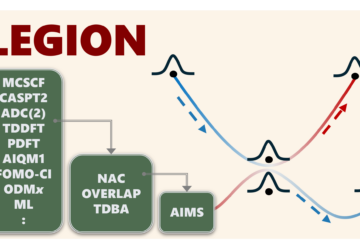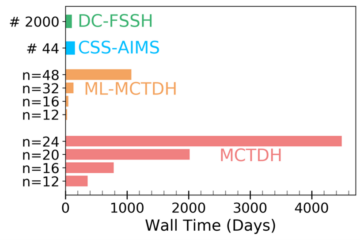For a small trajectory number, errors are not significant.
In brief:
- A benchmark of surface hopping for ethylene is compiled to check the impact of the velocity adjustment direction after hopping on the dynamics.
- For small trajectory ensembles (100 trajectories), the results are quantitatively equivalent within the margin of error.
- For medium-sized ensembles (500 trajectories), momentum-adjusted dynamics gives still acceptable results.
- For large ensembles (> 1000 trajectories), momentum-adjusted dynamics shows significant differences from the dynamics adjusted in the nonadiabatic coupling vector direction.
The most common surface hopping dynamics algorithms require velocity adjustment after hopping to ensure total-energy conservation. Based on the semiclassical analysis, such adjustment must be made parallel to the nonadiabatic coupling vector (h) direction. Nevertheless, this direction is not always known, and common practice has been to adjust the velocity in either the linear momentum (p) or velocity (v) directions.
A couple of papers by Ibele and Curchod and Plasser and colleagues have recently pointed out that the choice of direction could play a significant role in the outputs of the dynamics.
These findings raise the question: how reliable are all those dynamics based on methods like TD-DFT and ADC(2), invariably balancing energy in directions other than that of the nonadiabatic coupling vector?
I could not find a clear answer in the published works. For this reason, I decided to compute a benchmark of results especially tailored to evaluate the impact of the velocity-adjustment direction on decoherence-corrected fewest-switches surface hopping (DC-FSSH).
Note that it is not my goal to discuss which direction is the most adequate to make the velocity adjustment. This point is clearly settled; it is the nonadiabatic coupling vector’s direction. I want to address the following: considering that actual simulations based on on-the-fly electronic-structure calculations are done with relatively small trajectory ensembles, are the errors due to velocity-adjustment direction statistically significant?
My paper benchmarks surface hopping dynamics of photoexcited ethylene with velocity adjustment in several directions, including those of the nonadiabatic coupling vector h, the momentum p, and the energy gradient difference g. Moreover, I have defined clear protocols for the statistical analysis, including introducing the Λ[(1,2) score to compare different data sets.
The benchmark shows that:
- for small trajectory ensembles (100 trajectories), the results are quantitatively equivalent within the margin of error for 95% confidence.
- For medium-sized ensembles (500 trajectories), p-adjusted dynamics gives still acceptable results while g-adjusted already shows larger variations in relation to the h-adjusted reference data.
- For large ensembles (> 1000 trajectories), both p– and g-adjusted sets show significant differences from the h-adjusted set.
Other possible adjustment directions (velocity, single-state gradients, angular momentum) are evaluated as well.
This benchmark is limited to a single molecule and a single surface hopping variant. However, given the prototypical role of ethylene and the overwhelming adoption of DC-FSSH, the conclusions outlined here should be useful to inform on the maximum errors to expect when choosing a particular adjustment direction for surface hopping dynamics of other molecular systems.
MB
Reference
[1] M. Barbatti, Velocity Adjustment in Surface Hopping: Ethylene as a Case Study of the Maximum Error Caused by Direction Choice, J. Chem. Theory Comput., DOI:10.1021/acs.jctc.1c00012 (2021).


